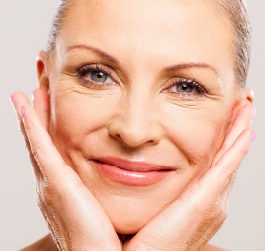In this blog we talk about how the skin ages and how Photorejuvenation treatments can help reduce the effects of skin ageing.
The first step in your journey to younger looking skin is to understand how human skin actually ages. There are many natural processes that age our appearance and these are outlined below.
Loss of collagen and elastin
Two primary structural components of the dermis – collagen & elastin, have been the subjects of the majority of anti-aging research. A loss of elastic fibres as well as a reduction in collagen, contributes to wrinkles by weakening the bond between dermis and epidermis. The overall collagen content per unit area of the skin surface is known to decline approximately 1% per year.
Loss of water
As we age, the skin becomes drier due to loss of water within the skin. Glycosaminoglycans such as hylauronic acid are located in the dermis and assist in binding water within the skin. The total hyaluronic acid level in the epidermis diminishes markedly as we age.
Loss of oil
The sebaceous glands also produce less oil as the skin ages. Men experience a minimal decrease, most often after the age of 80 but women gradually produce less oil beginning after menopause. In women, a deficiency in estrogens and androgens results in collagen degradation, dryness, loss of elasticity, epidermal atrophy and wrinkling of the skin.
Loss of resilience
With aging, the outer skin layer (epidermis) thins, even though the number of cell layers remains unchanged. The skin becomes more fragile and prone to lines from repetitively folding the skin. Dynamic lines are the wrinkles created by muscle movement under the skin. The skin also becomes more susceptible to lines from repetitive habits or movements such as sleeping on your face every night or drinking from a drink bottle!
Broken blood vessels
As the skin ages the blood vessels of the dermis become more fragile leading to redness. Spider veins, broken capillaries or telangiectasia are small red, blue or purple blood vessels under the skin and primarily located on the cheeks or sides of the nose. Genetic factors will make you more prone to broken blood vessels but damage to the skin via injury, sun exposure, extremes in temperature or smoking will cause them to become worse.
Loss of fat
The fat layer immediately under the skin thins so the skin has less insulation and volume. Gradual loss of skin elasticity also leads to sagging of the skin. Ageing of the entire face is associated with the gravity impact , loss of volume, diminishing and redistribution of fat and loss of bony skeleton support. Collectively, these factors lead to the face sagging, along with changes in shape and contour.
Slowing of skin shedding
We are constantly shedding our skin but as we age, this process slows. This slowing of epidermal turnover rate makes the skin less effective at removing dead skin. This gives the skin a dull look, a rough texture and more prominent lines and wrinkles.
So – loss of collagen and elastin, water, oil, and fat as well as reduced cell turnover rate all contribute to skin ageing. Photoageing describes those ageing changes in our skin that are caused by the sun – particularly wrinkles and uneven pigmentation. The term Photorejuvenation describes the various treatments that are able to reverse some of these changes.
What can you do to help reduce the signs of ageing and what is Photorejuvenation?
At the Encorė Cosmetic Clinic, we utilise Laser resurfacing with our tunable Sciton™ Erbium laser to deliver photo rejuvenation at various levels – the superficial Nanolaser Peel, the medium depth Microlaser Peel or full face deeper resurfacing.
As well as these treatments Botox®, Dysport® , Dermal Fillers and our Sciton Forever Young BBL® all can improve the signs of ageing
Follow our blogs for anti-aging tips and tricks plus other information on the ways you can combat the signs of aging.
Janelle Holton-Lowe
Appearance Nurse Specialist
BN RN Dip Beauty Therapy

